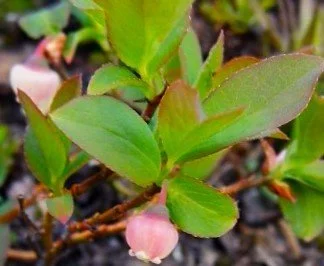 Image 1 of 4
Image 1 of 4

 Image 2 of 4
Image 2 of 4

 Image 3 of 4
Image 3 of 4

 Image 4 of 4
Image 4 of 4





Vaccinium membranaceum (Thin-leaved Huckleberry)
A rare find for the lowland landscape — we have been growing this alpine huckleberry for several years in our nursery to finally bring you a little taste of the mountains in your own home landscape!
This huckleberry features some of the choicest of our native huckleberry fruits, with very flavorful, juicy berries that have been prized by First Peoples for generations, and are highly sought by hikers to eat fresh or collect for huckleberry jams, syrups, pies, and more. In the landscape, it provides habitat in the form of low cover (it grows ~1-4 ft. over time, depending on the site conditions), flowers for pollinators, and berries for birds and small mammals. Its roots provide excellent soil binding, as they can penetrate up to 40 in., and the rhizomes may be as deep as 3-12 in.
The flowers are creamy-pink, classic huckleberry urn-shaped, and the berries are purplish or reddish-black, without a waxy bloom. In autumn, the leaves turn a spectacular red to purple. Unlike our lowland huckleberries, this alpine thin-leaf huckleberry needs plenty of sun and is at its best without sharing the space with other woody plants that may crowd it out over time. In nature, one often finds it with Beargrass (Xerophyllum tenax), so that’s a good companion to try to recreate that alpine look in your own landscape!
Flowers bloom in late spring through June, and the fruits ripen mid- to late-summer. These are drought tolerant, but the berries may be sweeter if you give the plants a bit of water as the fruits are developing (and adding a little organic matter as top dressing will retain moisture, too). Huckleberry plants start small, but your patience will be rewarded with delicious alpine berries and gorgeous fall color over time!
A rare find for the lowland landscape — we have been growing this alpine huckleberry for several years in our nursery to finally bring you a little taste of the mountains in your own home landscape!
This huckleberry features some of the choicest of our native huckleberry fruits, with very flavorful, juicy berries that have been prized by First Peoples for generations, and are highly sought by hikers to eat fresh or collect for huckleberry jams, syrups, pies, and more. In the landscape, it provides habitat in the form of low cover (it grows ~1-4 ft. over time, depending on the site conditions), flowers for pollinators, and berries for birds and small mammals. Its roots provide excellent soil binding, as they can penetrate up to 40 in., and the rhizomes may be as deep as 3-12 in.
The flowers are creamy-pink, classic huckleberry urn-shaped, and the berries are purplish or reddish-black, without a waxy bloom. In autumn, the leaves turn a spectacular red to purple. Unlike our lowland huckleberries, this alpine thin-leaf huckleberry needs plenty of sun and is at its best without sharing the space with other woody plants that may crowd it out over time. In nature, one often finds it with Beargrass (Xerophyllum tenax), so that’s a good companion to try to recreate that alpine look in your own landscape!
Flowers bloom in late spring through June, and the fruits ripen mid- to late-summer. These are drought tolerant, but the berries may be sweeter if you give the plants a bit of water as the fruits are developing (and adding a little organic matter as top dressing will retain moisture, too). Huckleberry plants start small, but your patience will be rewarded with delicious alpine berries and gorgeous fall color over time!
